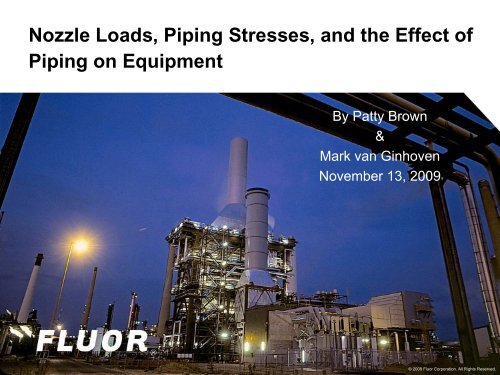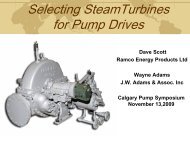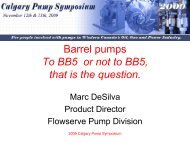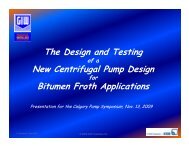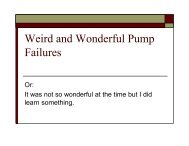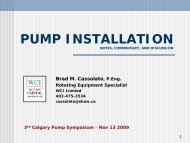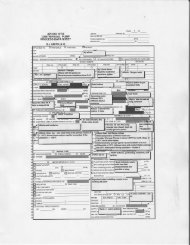Nozzle Loads, Piping Stresses, and the Effect of Piping on Equipment
Nozzle Loads, Piping Stresses, and the Effect of Piping on Equipment
Nozzle Loads, Piping Stresses, and the Effect of Piping on Equipment
Create successful ePaper yourself
Turn your PDF publications into a flip-book with our unique Google optimized e-Paper software.
<str<strong>on</strong>g>Nozzle</str<strong>on</strong>g> <str<strong>on</strong>g>Loads</str<strong>on</strong>g>, <str<strong>on</strong>g>Piping</str<strong>on</strong>g> <str<strong>on</strong>g>Stresses</str<strong>on</strong>g>, <str<strong>on</strong>g>and</str<strong>on</strong>g> <str<strong>on</strong>g>the</str<strong>on</strong>g> <str<strong>on</strong>g>Effect</str<strong>on</strong>g> <str<strong>on</strong>g>of</str<strong>on</strong>g><br />
<str<strong>on</strong>g>Piping</str<strong>on</strong>g> <strong>on</strong> <strong>Equipment</strong><br />
By Patty Brown<br />
&<br />
Mark van Ginhoven<br />
November 13, 2009<br />
1<br />
CA<br />
© 2009 Fluor Corporati<strong>on</strong>. All Rights Reserved.
Topics Covered<br />
• Introducti<strong>on</strong><br />
• <str<strong>on</strong>g>Nozzle</str<strong>on</strong>g> <str<strong>on</strong>g>Loads</str<strong>on</strong>g> – What are <str<strong>on</strong>g>the</str<strong>on</strong>g>y?<br />
• API 610 vs. ANSI Allowable Forces <str<strong>on</strong>g>and</str<strong>on</strong>g><br />
Moments<br />
• <str<strong>on</strong>g>Nozzle</str<strong>on</strong>g> Load Issues for Different Pump<br />
Types<br />
• Informati<strong>on</strong> Stress Engineering Needs<br />
• Special Cases<br />
Please feel free to ask questi<strong>on</strong>s!<br />
2
Introducti<strong>on</strong><br />
• As Mechanical <strong>Equipment</strong> Engineers, we<br />
need to underst<str<strong>on</strong>g>and</str<strong>on</strong>g> how our equipment<br />
interacts with <str<strong>on</strong>g>the</str<strong>on</strong>g> o<str<strong>on</strong>g>the</str<strong>on</strong>g>r aspects <str<strong>on</strong>g>of</str<strong>on</strong>g> <str<strong>on</strong>g>the</str<strong>on</strong>g><br />
plant, especially piping.<br />
• All API equipment codes have formulas or<br />
tables for “Allowable <str<strong>on</strong>g>Nozzle</str<strong>on</strong>g> <str<strong>on</strong>g>Loads</str<strong>on</strong>g>” – but<br />
what do <str<strong>on</strong>g>the</str<strong>on</strong>g>y really mean?<br />
• Lets go back to our university statics<br />
course for a moment…<br />
3
What are <str<strong>on</strong>g>Nozzle</str<strong>on</strong>g> <str<strong>on</strong>g>Loads</str<strong>on</strong>g>?<br />
• <str<strong>on</strong>g>Nozzle</str<strong>on</strong>g> loads are <str<strong>on</strong>g>the</str<strong>on</strong>g> net forces <str<strong>on</strong>g>and</str<strong>on</strong>g><br />
moments exerted <strong>on</strong> equipment nozzles<br />
from <str<strong>on</strong>g>the</str<strong>on</strong>g> weight <str<strong>on</strong>g>and</str<strong>on</strong>g> <str<strong>on</strong>g>the</str<strong>on</strong>g>rmal expansi<strong>on</strong> <str<strong>on</strong>g>of</str<strong>on</strong>g><br />
c<strong>on</strong>nected piping <str<strong>on</strong>g>and</str<strong>on</strong>g> equipment.<br />
• The loads exerted <strong>on</strong> equipment are<br />
directly related to how <str<strong>on</strong>g>the</str<strong>on</strong>g> equipment <str<strong>on</strong>g>and</str<strong>on</strong>g><br />
piping are supported.<br />
• Increased nozzle loads are a cause <str<strong>on</strong>g>of</str<strong>on</strong>g><br />
misalignment <str<strong>on</strong>g>and</str<strong>on</strong>g> increased wear <str<strong>on</strong>g>and</str<strong>on</strong>g><br />
vibrati<strong>on</strong> rates in pumps.<br />
4
What are <strong>Equipment</strong> <str<strong>on</strong>g>Nozzle</str<strong>on</strong>g> <str<strong>on</strong>g>Loads</str<strong>on</strong>g>?<br />
C<strong>on</strong>tinued…<br />
• Thermal Growth<br />
– l = growth<br />
– d = centreline to nozzle<br />
flange distance<br />
– = <str<strong>on</strong>g>the</str<strong>on</strong>g>rmal growth factor<br />
– (for Carb<strong>on</strong> Steel @ 100C<br />
= 1.1in/100ft)<br />
• On an OH2 pump, <str<strong>on</strong>g>the</str<strong>on</strong>g><br />
discharge nozzle will<br />
grow with<br />
temperature, exerting<br />
a force <strong>on</strong> <str<strong>on</strong>g>the</str<strong>on</strong>g> piping<br />
above.<br />
5
What are <strong>Equipment</strong> <str<strong>on</strong>g>Nozzle</str<strong>on</strong>g> <str<strong>on</strong>g>Loads</str<strong>on</strong>g>?<br />
C<strong>on</strong>tinued…<br />
• Between bearing pumps are<br />
more complicated because <str<strong>on</strong>g>the</str<strong>on</strong>g><br />
nozzles <str<strong>on</strong>g>the</str<strong>on</strong>g>rmally grow up from<br />
<str<strong>on</strong>g>the</str<strong>on</strong>g> centreline, as well as<br />
horiz<strong>on</strong>tally away from <str<strong>on</strong>g>the</str<strong>on</strong>g><br />
centreline.<br />
d v = centreline to top <str<strong>on</strong>g>of</str<strong>on</strong>g> nozzle<br />
l v = vertical nozzle growth<br />
d s = centreline to centre <str<strong>on</strong>g>of</str<strong>on</strong>g> sucti<strong>on</strong> nozzle<br />
l s = sucti<strong>on</strong> nozzle horiz<strong>on</strong>tal growth<br />
d d = centreline to centre <str<strong>on</strong>g>of</str<strong>on</strong>g> discharge<br />
nozzle<br />
l d = discharge nozzle horiz<strong>on</strong>tal growth<br />
• Assuming point <str<strong>on</strong>g>of</str<strong>on</strong>g> zero<br />
expansi<strong>on</strong> is <str<strong>on</strong>g>the</str<strong>on</strong>g> centreline <str<strong>on</strong>g>of</str<strong>on</strong>g><br />
<str<strong>on</strong>g>the</str<strong>on</strong>g> shaft<br />
6
The <str<strong>on</strong>g>Piping</str<strong>on</strong>g> <str<strong>on</strong>g>Effect</str<strong>on</strong>g><br />
• <str<strong>on</strong>g>Piping</str<strong>on</strong>g> adds ano<str<strong>on</strong>g>the</str<strong>on</strong>g>r dimensi<strong>on</strong><br />
• The layout <str<strong>on</strong>g>and</str<strong>on</strong>g> support <str<strong>on</strong>g>of</str<strong>on</strong>g> <str<strong>on</strong>g>the</str<strong>on</strong>g> piping will affect<br />
<str<strong>on</strong>g>the</str<strong>on</strong>g> forces <str<strong>on</strong>g>and</str<strong>on</strong>g> moments exerted <strong>on</strong> <str<strong>on</strong>g>the</str<strong>on</strong>g><br />
equipment.<br />
• The net force <strong>on</strong> <str<strong>on</strong>g>the</str<strong>on</strong>g> discharge nozzle <str<strong>on</strong>g>of</str<strong>on</strong>g> a pump<br />
is <str<strong>on</strong>g>the</str<strong>on</strong>g> force <str<strong>on</strong>g>of</str<strong>on</strong>g> <str<strong>on</strong>g>the</str<strong>on</strong>g> piping weight <str<strong>on</strong>g>and</str<strong>on</strong>g> <str<strong>on</strong>g>the</str<strong>on</strong>g>rmal<br />
expansi<strong>on</strong> load minus <str<strong>on</strong>g>the</str<strong>on</strong>g> force <str<strong>on</strong>g>of</str<strong>on</strong>g> <str<strong>on</strong>g>the</str<strong>on</strong>g> nozzle’s<br />
<str<strong>on</strong>g>the</str<strong>on</strong>g>rmal growth.<br />
• “For horiz<strong>on</strong>tal pumps, two effects <str<strong>on</strong>g>of</str<strong>on</strong>g> nozzle<br />
loads are c<strong>on</strong>sidered: Distorti<strong>on</strong> <str<strong>on</strong>g>of</str<strong>on</strong>g> <str<strong>on</strong>g>the</str<strong>on</strong>g> pump<br />
casing <str<strong>on</strong>g>and</str<strong>on</strong>g> misalignment <str<strong>on</strong>g>of</str<strong>on</strong>g> <str<strong>on</strong>g>the</str<strong>on</strong>g> pump <str<strong>on</strong>g>and</str<strong>on</strong>g> driver<br />
shafts.”<br />
API 610 10 th Ed. 5.5.1<br />
7
Factors that Affect <str<strong>on</strong>g>Nozzle</str<strong>on</strong>g> <str<strong>on</strong>g>Loads</str<strong>on</strong>g><br />
• Temperature<br />
– Affects expansi<strong>on</strong> <str<strong>on</strong>g>of</str<strong>on</strong>g> piping/equipment<br />
• Pressure<br />
– Affects pipe stiffness (more pressure = thicker pipe)<br />
• Client piping layout requirements<br />
– Valves at grade or overhead<br />
– Maintenance access<br />
• Steel / Support locati<strong>on</strong>s available<br />
• Baseplate design<br />
8
Stress Engineering Tools<br />
• Stress engineers use specialized FEA s<str<strong>on</strong>g>of</str<strong>on</strong>g>tware<br />
packages to do calculati<strong>on</strong>s (AutoPIPE ® ,<br />
CAESAR II)<br />
• Allows engineer to build a 3D model <str<strong>on</strong>g>of</str<strong>on</strong>g> <str<strong>on</strong>g>the</str<strong>on</strong>g><br />
piping system, add supports, temperature <str<strong>on</strong>g>and</str<strong>on</strong>g><br />
pressure informati<strong>on</strong>, <str<strong>on</strong>g>and</str<strong>on</strong>g> see how <str<strong>on</strong>g>the</str<strong>on</strong>g> piping<br />
reacts<br />
• Shows movement <str<strong>on</strong>g>of</str<strong>on</strong>g> <str<strong>on</strong>g>the</str<strong>on</strong>g> pipe, stresses <strong>on</strong> <str<strong>on</strong>g>the</str<strong>on</strong>g><br />
pipe, <str<strong>on</strong>g>and</str<strong>on</strong>g> loads <strong>on</strong> supports <str<strong>on</strong>g>and</str<strong>on</strong>g> equipment<br />
flanges<br />
• AutoPIPE ® Break…<br />
– 6x4 OH2 Pump<br />
– Flow = 909gpm, Head = 426ft, HP = 150hp<br />
9
Pump <str<strong>on</strong>g>Nozzle</str<strong>on</strong>g>s<br />
10
Max ratio<br />
Same layout<br />
showing ASME<br />
B31.3 code<br />
stresses (ratio)<br />
11
Thermal expansi<strong>on</strong><br />
<str<strong>on</strong>g>of</str<strong>on</strong>g> piping system<br />
(exaggerated to<br />
show movement)<br />
12
<str<strong>on</strong>g>Piping</str<strong>on</strong>g> Support Types<br />
• Vertical Support – keeps <str<strong>on</strong>g>the</str<strong>on</strong>g><br />
pipe from falling down<br />
– Eg. Support steel, shoe, base<br />
support, spring<br />
• Horiz<strong>on</strong>tal Guide – holds <str<strong>on</strong>g>the</str<strong>on</strong>g><br />
pipe parallel to its axis<br />
• Directi<strong>on</strong>al Anchor (DA) –<br />
holds <str<strong>on</strong>g>the</str<strong>on</strong>g> pipe perpendicular<br />
to its axis; <str<strong>on</strong>g>the</str<strong>on</strong>g>rmal growth<br />
will occur in both directi<strong>on</strong>s<br />
al<strong>on</strong>g <str<strong>on</strong>g>the</str<strong>on</strong>g> pipe axis<br />
• Full Anchor – combinati<strong>on</strong> <str<strong>on</strong>g>of</str<strong>on</strong>g><br />
a guide <str<strong>on</strong>g>and</str<strong>on</strong>g> directi<strong>on</strong>al<br />
anchor; pipe will not move in<br />
any directi<strong>on</strong><br />
Typical pipe support<br />
details<br />
Guide - no shoe<br />
Directi<strong>on</strong>al Anchor - no<br />
shoe<br />
Shoe<br />
Guide - w/ shoe<br />
Directi<strong>on</strong>al Anchor - w/<br />
shoe<br />
13
Special <str<strong>on</strong>g>Piping</str<strong>on</strong>g> Supports<br />
• Variable Spring<br />
– Takes <str<strong>on</strong>g>the</str<strong>on</strong>g> weight load (GR) to<br />
reduce load in vertical directi<strong>on</strong><br />
– Does not impose a reacti<strong>on</strong><br />
load because spring moves up<br />
or down<br />
– As pipe moves, spring reacts<br />
• C<strong>on</strong>stant Spring<br />
– Similar to variable spring<br />
– Used for vertical movements ><br />
3”<br />
– Reduces variability<br />
14
Special <str<strong>on</strong>g>Piping</str<strong>on</strong>g> Supports c<strong>on</strong>tinued…<br />
• Strut<br />
– Used for restraint <str<strong>on</strong>g>of</str<strong>on</strong>g> piping<br />
systems near critical equipment<br />
– Adjustable; zero gap, zero fricti<strong>on</strong><br />
– Better than Guides <str<strong>on</strong>g>and</str<strong>on</strong>g> DAs at<br />
restraining <str<strong>on</strong>g>the</str<strong>on</strong>g>rmal/fricti<strong>on</strong> loads<br />
– Not dependant <strong>on</strong> steel locati<strong>on</strong>;<br />
can adjust locati<strong>on</strong> inches at a<br />
time<br />
• Tefl<strong>on</strong> Slide Plate (TSP)<br />
– Reduces fricti<strong>on</strong> so support can<br />
slide easily<br />
– Usually placed under a shoe or<br />
base support<br />
– Allows expansi<strong>on</strong> <str<strong>on</strong>g>of</str<strong>on</strong>g> pipe &<br />
equipment to reach steady state<br />
without overcoming a large fricti<strong>on</strong><br />
force<br />
15
Typical <str<strong>on</strong>g>Piping</str<strong>on</strong>g> Layout<br />
• Try to negate forces <str<strong>on</strong>g>and</str<strong>on</strong>g> moments by supporting <str<strong>on</strong>g>the</str<strong>on</strong>g> pipe at <str<strong>on</strong>g>the</str<strong>on</strong>g><br />
same level as <str<strong>on</strong>g>the</str<strong>on</strong>g> pump. (Equal <str<strong>on</strong>g>the</str<strong>on</strong>g>rmal growth)<br />
16
Typical <str<strong>on</strong>g>Piping</str<strong>on</strong>g> Layout<br />
c<strong>on</strong>tinued…<br />
• First piping support<br />
before or after a<br />
nozzle is always an<br />
adjustable base<br />
support or a spring<br />
– Allows for proper alignment at<br />
site, as site c<strong>on</strong>diti<strong>on</strong>s never<br />
match <str<strong>on</strong>g>the</str<strong>on</strong>g> elevati<strong>on</strong>s in model.<br />
– Example shown is mounted<br />
<strong>on</strong> an elbow, but <str<strong>on</strong>g>the</str<strong>on</strong>g>se types<br />
<str<strong>on</strong>g>of</str<strong>on</strong>g> supports are used <strong>on</strong><br />
straight runs <str<strong>on</strong>g>of</str<strong>on</strong>g> pipe as well.<br />
Typical Adjustable Base Support<br />
17
Typical <str<strong>on</strong>g>Piping</str<strong>on</strong>g> Layout <str<strong>on</strong>g>and</str<strong>on</strong>g> Support –<br />
2x100% Pumps<br />
• Typical pump arrangements<br />
have <strong>on</strong>e pump spared (i.e.<br />
not running)<br />
• Thermal effect can be<br />
significant<br />
• <str<strong>on</strong>g>Piping</str<strong>on</strong>g> layout is typically<br />
symmetrical for es<str<strong>on</strong>g>the</str<strong>on</strong>g>tics, <str<strong>on</strong>g>and</str<strong>on</strong>g><br />
for equal flow if both pumps<br />
run toge<str<strong>on</strong>g>the</str<strong>on</strong>g>r<br />
• Minimize effect <str<strong>on</strong>g>of</str<strong>on</strong>g> downstream<br />
piping<br />
• AutoPIPE ® Break…<br />
– 14x10 BB2 Pumps<br />
– Flow = 4031gpm, Head =<br />
241ft, HP = 300hp<br />
18
Strut to restrain <str<strong>on</strong>g>the</str<strong>on</strong>g>rmal<br />
force in z directi<strong>on</strong><br />
Pump nozzles<br />
19
<str<strong>on</strong>g>Nozzle</str<strong>on</strong>g> <str<strong>on</strong>g>Loads</str<strong>on</strong>g><br />
with Strut<br />
Fx = 335 lb<br />
Fy = -2560 lb<br />
Fz = -1410 lb<br />
Mx = -3126 ft-lb<br />
My = 1927 ft-lb<br />
Mz = -3216 ft-lb<br />
<str<strong>on</strong>g>Nozzle</str<strong>on</strong>g> <str<strong>on</strong>g>Loads</str<strong>on</strong>g> without Strut<br />
20
API vs ANSI Pump Design<br />
API 610 ANSI B73.1<br />
Mounting Centreline Foot<br />
Casing<br />
Thickness Basis<br />
Max discharge<br />
pressure<br />
ASME B16.5 Class<br />
150 flange P/T rating<br />
Max<br />
Temperature<br />
By Manufacturer<br />
260C<br />
Flanges Class 300 Class 150<br />
21
API vs. ANSI <str<strong>on</strong>g>Nozzle</str<strong>on</strong>g> <str<strong>on</strong>g>Loads</str<strong>on</strong>g><br />
• All equipment codes have equati<strong>on</strong>s for<br />
nozzle loads<br />
– API 610 – Table 4 <str<strong>on</strong>g>and</str<strong>on</strong>g> Annex F<br />
– ANSI/HI 9.6.2<br />
• API 610 allows us three opti<strong>on</strong>s<br />
1. Individual <str<strong>on</strong>g>Loads</str<strong>on</strong>g> up to 1x Table 4 – OK<br />
2. Individual <str<strong>on</strong>g>Loads</str<strong>on</strong>g> up to 2x Table 4 – Apply Annex F<br />
– if all c<strong>on</strong>diti<strong>on</strong>s <str<strong>on</strong>g>of</str<strong>on</strong>g> Annex F are met – OK<br />
3. Any individual load >2x Table 4 – Pump vendor<br />
must be informed to do a detailed analysis, or piping<br />
will have to change to reduce loads.<br />
22
API vs. ANSI <str<strong>on</strong>g>Nozzle</str<strong>on</strong>g> <str<strong>on</strong>g>Loads</str<strong>on</strong>g><br />
c<strong>on</strong>tinued…<br />
– Annex F allows us to normalize <str<strong>on</strong>g>the</str<strong>on</strong>g> forces <str<strong>on</strong>g>and</str<strong>on</strong>g><br />
moments to take credit for low loads in a<br />
particular directi<strong>on</strong>.<br />
– Per API 610 5.5.5, “…use <str<strong>on</strong>g>of</str<strong>on</strong>g> Annex F<br />
methods can result in up to 50% greater<br />
misalignment than would occur using <str<strong>on</strong>g>the</str<strong>on</strong>g><br />
loads <str<strong>on</strong>g>of</str<strong>on</strong>g> Table 4.”<br />
– This risk is why <str<strong>on</strong>g>the</str<strong>on</strong>g> purchaser must agree to<br />
<str<strong>on</strong>g>the</str<strong>on</strong>g> use <str<strong>on</strong>g>of</str<strong>on</strong>g> Annex F.<br />
23
API vs. ANSI <str<strong>on</strong>g>Nozzle</str<strong>on</strong>g> <str<strong>on</strong>g>Loads</str<strong>on</strong>g><br />
c<strong>on</strong>tinued…<br />
Allowable<br />
<str<strong>on</strong>g>Loads</str<strong>on</strong>g><br />
API 610 Table 4 HI 9.6.2.1.1<br />
Allowable Individual <str<strong>on</strong>g>Nozzle</str<strong>on</strong>g> <str<strong>on</strong>g>Loads</str<strong>on</strong>g><br />
(ANSI Horiz<strong>on</strong>tal A80 6x4x13)<br />
6” End<br />
<str<strong>on</strong>g>Nozzle</str<strong>on</strong>g><br />
4” Top<br />
<str<strong>on</strong>g>Nozzle</str<strong>on</strong>g><br />
6” End<br />
<str<strong>on</strong>g>Nozzle</str<strong>on</strong>g><br />
F x (lb) 700 320 2700 1400<br />
F y (lb) 560 260 1350 1350<br />
F z (lb) 460 400 1500 3250<br />
F r (lb) 1010 570<br />
M x (ft lb) 1700 980 1300 1200<br />
M y (ft lb) 870 500 1300 1500<br />
M z (ft lb) 1300 740 1100 690<br />
M r (ft lb) 2310 1330<br />
4” Top <str<strong>on</strong>g>Nozzle</str<strong>on</strong>g><br />
24
API vs. ANSI <str<strong>on</strong>g>Nozzle</str<strong>on</strong>g> <str<strong>on</strong>g>Loads</str<strong>on</strong>g><br />
c<strong>on</strong>tinued…<br />
• ANSI nozzle loads d<strong>on</strong>’t look too bad when you look at<br />
<str<strong>on</strong>g>the</str<strong>on</strong>g> table <strong>on</strong> <str<strong>on</strong>g>the</str<strong>on</strong>g> previous slide<br />
• Deceiving, because <str<strong>on</strong>g>the</str<strong>on</strong>g>re are multiple tables, <str<strong>on</strong>g>and</str<strong>on</strong>g> a set<br />
<str<strong>on</strong>g>of</str<strong>on</strong>g> equati<strong>on</strong>s to meet, al<strong>on</strong>g with each table<br />
• Depending <strong>on</strong> material, temperature <str<strong>on</strong>g>and</str<strong>on</strong>g> baseplate<br />
mounting, derating factors are applied to <strong>on</strong>e or more <str<strong>on</strong>g>of</str<strong>on</strong>g><br />
<str<strong>on</strong>g>the</str<strong>on</strong>g> tables, reducing <str<strong>on</strong>g>the</str<strong>on</strong>g> allowable loads.<br />
• Recalling <str<strong>on</strong>g>the</str<strong>on</strong>g> first AutoPIPE ® model…<br />
– 6x4 Horiz<strong>on</strong>tal Pump<br />
– Flow = 909gpm, Head = 426ft, HP = 150hp<br />
• API 610 Fluor <str<strong>on</strong>g>Nozzle</str<strong>on</strong>g> Load Spreadsheet…<br />
• ANSI Fluor <str<strong>on</strong>g>Nozzle</str<strong>on</strong>g> Load Spreadsheet…<br />
25
API vs. ANSI <str<strong>on</strong>g>Nozzle</str<strong>on</strong>g> <str<strong>on</strong>g>Loads</str<strong>on</strong>g><br />
c<strong>on</strong>tinued…<br />
• ANSI pumps are not built as robustly as API pumps <str<strong>on</strong>g>and</str<strong>on</strong>g><br />
<str<strong>on</strong>g>the</str<strong>on</strong>g>refore have much lower allowable loads<br />
– At low temperatures (
<str<strong>on</strong>g>Nozzle</str<strong>on</strong>g> Load Issues for Different Pump<br />
Types<br />
• Horiz<strong>on</strong>tal Overhung (OH2)<br />
– Stress engineers calculate <str<strong>on</strong>g>the</str<strong>on</strong>g> <str<strong>on</strong>g>the</str<strong>on</strong>g>rmal growth<br />
<str<strong>on</strong>g>of</str<strong>on</strong>g> each nozzle <str<strong>on</strong>g>and</str<strong>on</strong>g> insert that into <str<strong>on</strong>g>the</str<strong>on</strong>g><br />
assumed anchor <str<strong>on</strong>g>of</str<strong>on</strong>g> <str<strong>on</strong>g>the</str<strong>on</strong>g> AutoPIPE calculati<strong>on</strong>.<br />
• Vertical In-Line (OH3)<br />
– Stress engineering needs to know if <str<strong>on</strong>g>the</str<strong>on</strong>g>se<br />
pumps are floating <strong>on</strong> <str<strong>on</strong>g>the</str<strong>on</strong>g> foundati<strong>on</strong>.<br />
– If <str<strong>on</strong>g>the</str<strong>on</strong>g>y are floating, <str<strong>on</strong>g>the</str<strong>on</strong>g> pump will move with<br />
<str<strong>on</strong>g>the</str<strong>on</strong>g> pipe expansi<strong>on</strong> at startup to a steady state<br />
positi<strong>on</strong>.<br />
27
<str<strong>on</strong>g>Nozzle</str<strong>on</strong>g> Load Issues for Different Pump<br />
Types c<strong>on</strong>tinued…<br />
• Between Bearing (BB1, BB2, BB3, BB5)<br />
– Since <str<strong>on</strong>g>the</str<strong>on</strong>g>se pumps are typically a top-top or<br />
side-side arrangement, <str<strong>on</strong>g>the</str<strong>on</strong>g> <str<strong>on</strong>g>the</str<strong>on</strong>g>rmal growth <str<strong>on</strong>g>of</str<strong>on</strong>g><br />
<str<strong>on</strong>g>the</str<strong>on</strong>g> nozzles is generally more significant.<br />
• Mechanical/Vendor needs to provide <str<strong>on</strong>g>the</str<strong>on</strong>g>se values<br />
as piping can’t always tell where <str<strong>on</strong>g>the</str<strong>on</strong>g> point <str<strong>on</strong>g>of</str<strong>on</strong>g> zero<br />
expansi<strong>on</strong> is<br />
– This is especially true <str<strong>on</strong>g>of</str<strong>on</strong>g> a high-temperature<br />
(>200C) barrel pump (BB5).<br />
28
High Temperature Barrel Pump<br />
• <str<strong>on</strong>g>Nozzle</str<strong>on</strong>g> <str<strong>on</strong>g>Loads</str<strong>on</strong>g>…<br />
• AutoPIPE ® Break…<br />
– 10x8 BB5 Pump<br />
– Flow = 1737gpm, Head = 6449, HP = 4500hp<br />
29
Numerous springs<br />
<str<strong>on</strong>g>and</str<strong>on</strong>g> struts to reduce<br />
piping imposed<br />
nozzle loads.<br />
High pressure (3325 psi) means thick walled<br />
(1.75”) piping <str<strong>on</strong>g>and</str<strong>on</strong>g> greatly reduced flexibility.<br />
30
Very low <str<strong>on</strong>g>the</str<strong>on</strong>g>rmal stresses in piping (ratio less than 0.2). Complicated<br />
design required to meet nozzle allowable loads.<br />
31
Why is piping always bugging me?<br />
• <str<strong>on</strong>g>Piping</str<strong>on</strong>g> needs <str<strong>on</strong>g>the</str<strong>on</strong>g> following informati<strong>on</strong> to do <str<strong>on</strong>g>the</str<strong>on</strong>g>ir work:<br />
– Pump type (API/ANSI)<br />
– GA Drawing <str<strong>on</strong>g>of</str<strong>on</strong>g> pump showing support locati<strong>on</strong>, nozzle<br />
distance from centreline, vendor allowable loads<br />
– Temperature info (usually from line list <str<strong>on</strong>g>and</str<strong>on</strong>g> P&ID)<br />
– Material <str<strong>on</strong>g>of</str<strong>on</strong>g> <str<strong>on</strong>g>the</str<strong>on</strong>g> pump (usually <strong>on</strong> <str<strong>on</strong>g>the</str<strong>on</strong>g> GA <str<strong>on</strong>g>and</str<strong>on</strong>g> datasheet)<br />
– ANSI flange size (150#, 300#, etc - usually <strong>on</strong> <str<strong>on</strong>g>the</str<strong>on</strong>g> GA or<br />
detailed drawings)<br />
– <str<strong>on</strong>g>Nozzle</str<strong>on</strong>g> movements from equipment zero point (point <str<strong>on</strong>g>of</str<strong>on</strong>g> zero<br />
<str<strong>on</strong>g>the</str<strong>on</strong>g>rmal growth)<br />
• especially important for high temperature equipment<br />
• This informati<strong>on</strong> is used for both <str<strong>on</strong>g>the</str<strong>on</strong>g> 3D model <str<strong>on</strong>g>and</str<strong>on</strong>g> <str<strong>on</strong>g>the</str<strong>on</strong>g><br />
AutoPIPE ® model.<br />
32
Why is piping always bugging me?<br />
C<strong>on</strong>tinued…<br />
• Similar informati<strong>on</strong> is required for o<str<strong>on</strong>g>the</str<strong>on</strong>g>r types <str<strong>on</strong>g>of</str<strong>on</strong>g> equipment<br />
• Complicated equipment like centrifugal compressors, heaters<br />
<str<strong>on</strong>g>and</str<strong>on</strong>g> reactors require more informati<strong>on</strong> from vendors like<br />
growth calculati<strong>on</strong>s, skin temperatures <str<strong>on</strong>g>and</str<strong>on</strong>g> layout <str<strong>on</strong>g>of</str<strong>on</strong>g> piping<br />
within <str<strong>on</strong>g>the</str<strong>on</strong>g> equipment<br />
• Reciprocating compressors <str<strong>on</strong>g>of</str<strong>on</strong>g>ten require acoustic analysis to<br />
see how <str<strong>on</strong>g>the</str<strong>on</strong>g> vibrati<strong>on</strong>s <str<strong>on</strong>g>of</str<strong>on</strong>g> <str<strong>on</strong>g>the</str<strong>on</strong>g> equipment affect <str<strong>on</strong>g>the</str<strong>on</strong>g> piping<br />
– See API 618 (Secti<strong>on</strong> 7.9.4.2 <str<strong>on</strong>g>and</str<strong>on</strong>g> Annex N)<br />
– Analysis usually d<strong>on</strong>e by a third-party, <str<strong>on</strong>g>and</str<strong>on</strong>g> includes all piping <str<strong>on</strong>g>and</str<strong>on</strong>g><br />
equipment<br />
– Also helps determine <str<strong>on</strong>g>the</str<strong>on</strong>g> need for pulsati<strong>on</strong> suppressi<strong>on</strong> devices<br />
33
Why is piping always bugging me?<br />
C<strong>on</strong>tinued…<br />
• Something to keep in mind:<br />
– Mechanical data supports piping design<br />
– Timely receipt <str<strong>on</strong>g>of</str<strong>on</strong>g> mechanical data is<br />
necessary to keep projects moving<br />
34
How can <str<strong>on</strong>g>Nozzle</str<strong>on</strong>g> <str<strong>on</strong>g>Loads</str<strong>on</strong>g> be Reduced?<br />
• Increase piping flexibility (add loops)<br />
• Add springs, struts <str<strong>on</strong>g>and</str<strong>on</strong>g> slide plates<br />
• Add hot by-pass (very comm<strong>on</strong>)<br />
• Can mount pumps <strong>on</strong> slide plates or springs<br />
• In extreme cases, add expansi<strong>on</strong> joints<br />
– Must be a low pressure system<br />
– Not recommended; expansi<strong>on</strong> joint is usually <str<strong>on</strong>g>the</str<strong>on</strong>g><br />
weakest point in <str<strong>on</strong>g>the</str<strong>on</strong>g> system<br />
35
Examples <str<strong>on</strong>g>of</str<strong>on</strong>g> Special Cases<br />
• Heavy Flanges (ANSI 1500#)<br />
– See Barrel Pump Example<br />
• High Temperature Pumps<br />
– See Barrel Pump Example<br />
• Sea Water Pumps (HDPE piping)<br />
– Expansi<strong>on</strong> joints<br />
• Reciprocating Compressors<br />
– Cast cylinder heads; very low allowable loads<br />
– Hold down supports, snubbers<br />
• Steam Turbines<br />
• Screw Pump Example…<br />
– 10x8 Screw Pump<br />
– Flow = 198.95 m 3 /h, ΔP = 2255 kPa, HP = 300hp<br />
36
Pumps rotated 180 deg. to reduce<br />
piping imposed loads. Limits access<br />
for maintenance.<br />
Pump nozzles<br />
Restraints to protect<br />
equipment from <str<strong>on</strong>g>the</str<strong>on</strong>g>rmal<br />
expansi<strong>on</strong><br />
37
38<br />
High operating temperature<br />
(343 deg C) means substantial<br />
<str<strong>on</strong>g>the</str<strong>on</strong>g>rmal movements.
References<br />
• Pumps<br />
– API 610 10 th Ed., Secti<strong>on</strong> 5.5 <str<strong>on</strong>g>and</str<strong>on</strong>g> Annex F<br />
– ANSI/HI 9.6.2 – Centrifugal <str<strong>on</strong>g>and</str<strong>on</strong>g> Vertical Pumps for Allowable<br />
<str<strong>on</strong>g>Nozzle</str<strong>on</strong>g> <str<strong>on</strong>g>Loads</str<strong>on</strong>g><br />
– PIP RESP002 – Design Of ASME B73.1 And General<br />
Purpose Pump Baseplates<br />
• Compressors<br />
– API 617 7 th Ed., Secti<strong>on</strong> 2.3.4 <str<strong>on</strong>g>and</str<strong>on</strong>g> Annex 2.E<br />
– API 618 5 th Ed., Secti<strong>on</strong> 7.9.4.2 <str<strong>on</strong>g>and</str<strong>on</strong>g> Annex N<br />
– API 619 4 th Ed., Secti<strong>on</strong> 5.4 <str<strong>on</strong>g>and</str<strong>on</strong>g> Annex C<br />
• <str<strong>on</strong>g>Piping</str<strong>on</strong>g><br />
– ASME B31.3 – 2008, Chapter II Part 5 – Flexibility <str<strong>on</strong>g>and</str<strong>on</strong>g><br />
Support<br />
39
Thank you!<br />
Any questi<strong>on</strong>s?<br />
Feel free to c<strong>on</strong>tact us:<br />
Patty Brown (403)537-4210<br />
Mark van Ginhoven (403)538-1171<br />
40


